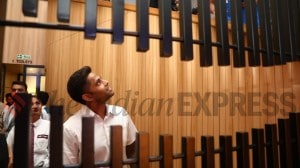Life is plastic,never mind
Álvarezs art may have been meant to imitate life. But in a culture saturated with such images,life is returning the compliment.
Frustrated with the modest sales at his small mannequin factory,Eliezer Álvarez made a simple observation: Venezuelan women were increasingly using plastic surgery to transform their bodies,yet the mannequins in clothing stores did not reflect these new,often extreme proportions.
So he went back to his workshop and created the kind of woman one with a bulging bosom and cantilevered buttocks,a wasp waist and long legs,a fibreglass fantasy,Venezuelan style.
His mannequins,and others like them,have become the standard in stores across Venezuela,serving as an exaggerated,sometimes polarising,vision of the female form that calls out from the doorways of tiny shops and the display windows of fancy boutiques.
Álvarezs art may have been meant to imitate life. But in a culture saturated with such images,life is returning the compliment.
You see a woman like this and you say,Wow,I want to look like her, said Reina Parada,as she sanded a mannequin torso in the workshop. Although she cannot afford it,she said,she would like to get implant surgery someday. It gives you better self-esteem.
Cosmetic procedures are so fashionable here that a woman with implants is often casually referred to as an operated woman. Women freely talk about their surgeries.
The embrace of plastic surgery clashes with the governments socialist ideology and frequent talk of creating a society free of the taint of commercialism. Venezuelas longtime leader Hugo Chávez,who died in March after 14 years in office,railed against the procedures,saying it was monstrous that poor women were spending money on breast surgeries when they had trouble making ends meet.
But the same resource that the government relies on the worlds largest estimated petroleum reserves has long fed a culture of easy money and consumerism here,along with a penchant for instant gratification.
Venezuela is known for its oil,and its known for its beauty, said Lauren Gulbas,an anthropologist at Dartmouth College,who has studied attitudes toward plastic surgery in Venezuela.
Beauty took on a particularly important role in the late 1970s and 80s when the countrys beauty queens,already a national obsession,were crowned Miss Universe three times. It came as the country was grappling with the frustrated expectations of the 1970s oil boom and the deep economic downturn that followed.
And the beauty queens fame helped fuel a fascination with procedures like breast implants,tummy tucks,nose jobs and injections to firm the buttocks.
Osmel Sousa,the longtime head of the Miss Venezuela pageant,takes credit for the trend. He recommended a nose job for Venezuelas first Miss Universe,which he says made her victory possible. If it can be easily fixed with surgery,then why not do it? Sousa said.
The little data available indicates that Venezuelan women do not get plastic surgery more than their counterparts in many other countries. But Gulbas said the surgeries take on an elevated status thanks to a belief that they will help project a successful image.
Over the last two years,the local news media has reported several cases in which women died after receiving faulty injections,often in unlicensed clinics.
A few miles from Corros workshop,workers used a similar process to build mannequins in a small rooftop workshop run by Daniela Mieles,25,and her family.
Mieles said that the busts and buttocks of her mannequins had grown gradually to keep up with the plastic surgery trends.
Now they have reached a shape that her husband,Trino Colmenarez,32,calls estrambótico,a word that may be best translated as extravagant.
She and her husband had started saving money so that she could get breast implants herself. An operation at a private clinic can cost about $6,350,Mieles said,an amount equivalent to about three months of basic expenses for her household.
Beauty is perfection,to try to perfect yourself more and more every day, Mieles said. Thats how people see it here.






- 01
- 02
- 03
- 04
- 05

























